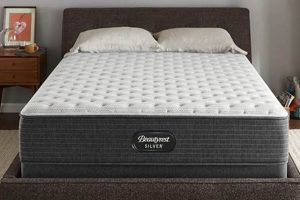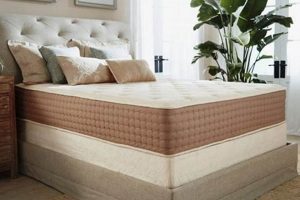Selecting the most suitable overlay for a mattress involves considering materials, thickness, and intended use. These additions sit atop a mattress to alter its feel, offering options ranging from enhanced cushioning to improved support. For example, a memory foam option conforms to the body, potentially alleviating pressure points, while a latex selection provides a more responsive and buoyant surface.
The correct mattress enhancement can significantly improve sleep quality by addressing issues such as discomfort from a too-firm or too-soft mattress. Historically, these products have evolved from simple padding to sophisticated designs incorporating advanced materials and technologies. Their importance lies in their ability to extend the life of a mattress and customize the sleep experience without the expense of replacing the entire mattress.
The following sections will delve into various materials commonly used in these products, analyze their performance characteristics, and provide guidance on choosing the optimal solution based on individual needs and preferences. Understanding these factors is critical to making an informed decision.
Guidance on Selecting an Optimal Mattress Overlay
This section provides actionable advice for choosing a mattress overlay that meets individual requirements and enhances sleep quality. Consideration of these factors is crucial for maximizing the benefits of this bedding accessory.
Tip 1: Material Composition: Prioritize material based on desired feel and support. Memory foam contours to the body, while latex offers greater responsiveness. Down and feather provide softness but may lack adequate support for some individuals.
Tip 2: Thickness Considerations: A thicker overlay generally provides more substantial cushioning and support. However, it may also alter the overall bed height, potentially requiring adjustments to bedding and room aesthetics. Evaluate thickness in relation to existing mattress firmness.
Tip 3: Density Evaluation: Density impacts durability and support. Higher density materials, particularly in memory foam and latex, tend to last longer and provide superior pressure relief. Lower density options may compress more quickly and offer less long-term support.
Tip 4: Temperature Regulation: Certain materials retain more heat than others. If overheating is a concern, consider overlays with cooling properties, such as gel-infused memory foam or those incorporating breathable fabrics like bamboo.
Tip 5: Allergen Sensitivity: Individuals with allergies should opt for hypoallergenic materials. Latex is naturally resistant to dust mites and mold, while synthetic materials can be treated to reduce allergen accumulation.
Tip 6: Support Needs: Individuals with back pain or specific support needs should consider an overlay that offers targeted spinal alignment. Options with zoned support or firmer materials can help maintain proper posture during sleep.
Tip 7: Budget Considerations: Prices vary significantly depending on material and features. Establish a budget and compare options within that range, prioritizing essential features over non-essential extras.
Tip 8: Warranty and Return Policies: Review warranty terms and return policies before purchasing. This allows for adequate trial and ensures recourse if the overlay does not meet expectations.
Careful consideration of material, thickness, density, temperature regulation, allergen sensitivity, support needs, budget, and warranty terms will facilitate the selection of a mattress overlay that significantly improves sleep quality and overall comfort.
The subsequent sections will delve into a comparative analysis of specific materials, providing detailed insights into their performance characteristics and suitability for various sleep preferences.
1. Material Density
Material density, measured as mass per unit volume, critically affects the performance and longevity of a mattress overlay. Higher density materials, typically found in memory foam and latex options, offer greater resistance to compression, leading to enhanced support and durability. A high-density memory foam overlay, for example, conforms closely to the body, distributing weight evenly and alleviating pressure points, while a low-density option may compress excessively, providing inadequate support and diminishing its lifespan. This difference is particularly pronounced over time, as high-density materials retain their shape and support capabilities for longer periods.
The practical significance of understanding material density extends to cost-effectiveness. While lower-density overlays may present a lower initial price point, their reduced lifespan and diminished performance necessitate more frequent replacements. High-density options, conversely, represent a longer-term investment, providing consistent support and comfort over an extended period. For example, a high-density latex overlay might maintain its structural integrity for several years, while a lower-density polyurethane foam alternative could degrade within a shorter timeframe, resulting in sagging and reduced support. Consequently, considering material density is crucial for aligning product selection with long-term needs and budgetary considerations.
In summary, material density is a pivotal determinant of a mattress overlay’s performance, durability, and long-term value. Selecting options with appropriate densities ensures optimal support, pressure relief, and lifespan, translating to improved sleep quality and a more cost-effective investment. The challenge lies in accurately assessing material density, often requiring careful scrutiny of product specifications and independent reviews to ensure informed decision-making. This understanding connects directly to the broader theme of choosing a suitable overlay that addresses individual sleep preferences and needs.
2. Support Characteristics
Support characteristics are a fundamental determinant of a mattress overlay’s suitability for individual needs. These characteristics, encompassing firmness, contouring, and edge support, directly influence spinal alignment and pressure distribution, which are critical for achieving restful sleep. A supportive overlay, for example, maintains the natural curvature of the spine, preventing misalignment that can lead to back pain or discomfort. Conversely, an insufficiently supportive overlay may exacerbate existing spinal issues or create new ones. The material’s ability to evenly distribute body weight minimizes pressure points, particularly in the shoulders and hips, promoting circulation and reducing tossing and turning. The effectiveness of these characteristics is contingent on the overlay’s material composition and construction.
Different materials offer varying degrees of support. Memory foam, kn
own for its contouring properties, conforms closely to the body, providing targeted support and pressure relief. Latex, conversely, offers a more responsive and buoyant support, maintaining spinal alignment without excessive sinking. Innerspring overlays provide firm, consistent support, while down and feather options offer minimal support, primarily enhancing surface softness. The selection of an overlay with appropriate support characteristics is paramount for individuals with specific physical conditions or sleep preferences. For example, individuals with back pain may benefit from a firmer, more supportive overlay, while those seeking enhanced comfort may prefer a softer, more contouring option.
In conclusion, support characteristics represent a critical dimension in the selection of a mattress overlay, influencing spinal alignment, pressure distribution, and overall sleep quality. Understanding the interplay between material properties and support is essential for aligning product selection with individual needs and preferences. The challenge lies in objectively assessing support characteristics, often necessitating careful evaluation of product specifications, independent reviews, and, ideally, in-person testing to ensure a suitable match. This alignment is vital for optimizing sleep and mitigating potential discomfort or health issues related to inadequate support.
3. Thermal Regulation
Thermal regulation is a critical factor in determining the suitability of a mattress overlay, influencing sleep comfort and overall well-being. Overlays lacking effective thermal management can trap body heat, leading to discomfort, night sweats, and disrupted sleep cycles. The material composition of the topper directly dictates its thermal properties. For example, traditional memory foam, while known for its pressure-relieving qualities, tends to retain heat. This can result in an elevated sleep surface temperature, especially in warmer climates or for individuals prone to night sweats. Consequently, overlays incorporating cooling technologies, such as gel-infused memory foam or breathable fabrics like bamboo, are increasingly sought after for their enhanced thermal performance. These materials facilitate airflow and dissipate heat, maintaining a more comfortable sleep environment.
The effectiveness of thermal regulation depends not only on the material but also on the overlay’s design and construction. Open-cell foam structures, for instance, promote better airflow compared to closed-cell structures. Similarly, quilted or channeled designs can enhance ventilation, further reducing heat retention. Real-world applications demonstrate the practical significance of thermal regulation in mattress overlays. Individuals residing in humid climates or those experiencing hormonal fluctuations, such as menopausal women, often report significant improvements in sleep quality when using overlays with enhanced cooling properties. Conversely, the use of heat-retaining overlays in such scenarios can exacerbate discomfort and sleep disturbances. Therefore, understanding and prioritizing thermal regulation is essential for selecting an overlay that promotes optimal sleep comfort.
In summary, thermal regulation is an indispensable consideration in the selection of a mattress overlay. The overlay’s ability to effectively manage heat directly impacts sleep comfort and overall well-being. While material composition and construction are key determinants of thermal performance, individual needs and environmental factors should also be taken into account. The challenge lies in identifying overlays that strike a balance between thermal regulation, support, and comfort, necessitating careful evaluation of product specifications and independent reviews. Addressing this challenge is vital for ensuring a restful and restorative sleep experience.
4. Thickness Options
Thickness options within mattress overlays directly influence the degree of comfort and support modification provided. A thicker overlay generally offers more significant cushioning and pressure relief, while a thinner overlay provides a subtle adjustment to the existing mattress feel. The choice of thickness is not arbitrary; it should correspond to the specific needs of the individual and the existing characteristics of the mattress. For instance, a person seeking to alleviate pressure points on a firm mattress might benefit from a thicker, high-density memory foam overlay. Conversely, someone aiming to subtly enhance the softness of a relatively new mattress might opt for a thinner option. Selecting the appropriate thickness is therefore a critical step in identifying an optimal mattress overlay.
The practical significance of understanding thickness options is evident in several scenarios. Consider an individual with back pain seeking to improve spinal alignment. A thicker overlay can provide greater support and contouring, helping to maintain proper posture during sleep. Conversely, a thicker overlay on an already soft mattress might lead to excessive sinking, exacerbating back pain. The interplay between thickness and support necessitates careful consideration. Furthermore, thickness also affects the overall bed height, potentially requiring adjustments to bedding and bedroom aesthetics. A very thick overlay may necessitate deeper fitted sheets, altering the overall cost and convenience of the bedding setup. Therefore, both the functional and practical implications of thickness must be weighed.
In summary, thickness options represent a key determinant in selecting a mattress overlay that aligns with individual needs and preferences. The choice of thickness should be guided by the desired level of comfort and support modification, as well as the existing characteristics of the mattress. Consideration of both functional and practical implications is essential for ensuring that the overlay effectively addresses the user’s needs without introducing new challenges. This understanding is crucial for making informed decisions and maximizing the benefits derived from a mattress overlay.
5. Allergen Resistance
Allergen resistance is a pivotal attribute when evaluating mattress overlays, directly impacting sleep quality and respiratory health. Overlays lacking inherent or treated allergen resistance can harbor dust mites, mold, and other allergens, triggering allergic reactions and exacerbating respiratory conditions. The proliferation of these allergens within the sleep environment can manifest as symptoms ranging from nasal congestion and sneezing to skin irritation and asthma exacerbations. Consequently, the selection of a mattress overlay with effective allergen resistance is paramount, particularly for individuals with allergies or sensitivities. The choice of material and construction significantly influences the allergen-resistant properties of an overlay. Certain materials, such as natural latex, possess inherent resistance to dust mites and mold, while others, such as synthetic fibers, require specialized treatments to achieve comparable levels of allergen protection. Therefore, understanding the connection between material composition and allergen resistance is crucial for making informed decisions.
Real-world examples underscore the practical significance of allergen resistan
ce in mattress overlays. Individuals with dust mite allergies often experience a noticeable reduction in symptoms upon switching to a latex overlay or one treated with antimicrobial agents. Conversely, the use of an untreated, high-pile overlay can exacerbate allergic reactions, leading to disrupted sleep and impaired daytime functioning. The efficacy of allergen resistance extends beyond the material itself; proper maintenance, including regular washing and vacuuming, is essential for preventing allergen accumulation. Some overlays feature removable, washable covers, facilitating hygiene and minimizing allergen exposure. The effectiveness of these measures is contingent upon consistent adherence to recommended cleaning practices. Therefore, selecting an overlay with accessible and easily maintained allergen-resistant properties is a practical consideration.
In summary, allergen resistance is an indispensable consideration in the selection of a mattress overlay, directly impacting sleep quality and respiratory health. The choice of material, construction, and maintenance practices collectively determine the overlay’s effectiveness in minimizing allergen exposure. While inherent allergen resistance is desirable, treated options can provide comparable levels of protection, provided they are properly maintained. The challenge lies in identifying overlays that strike a balance between allergen resistance, comfort, and affordability, necessitating careful evaluation of product specifications and independent reviews. Addressing this challenge is vital for ensuring a sleep environment that promotes both restful sleep and respiratory well-being.
Frequently Asked Questions
This section addresses common inquiries regarding mattress overlays, providing clear and concise answers to assist in making informed purchasing decisions.
Question 1: What materials are commonly used in mattress overlays?
Common materials include memory foam, latex, down, feathers, wool, and various synthetic fibers. Each material offers distinct characteristics in terms of support, comfort, and thermal regulation.
Question 2: How does the thickness of a mattress overlay impact its performance?
Thickness directly influences the level of cushioning and support provided. Thicker overlays generally offer more substantial pressure relief, while thinner overlays provide a subtle adjustment to the existing mattress feel.
Question 3: Is a mattress overlay necessary if the existing mattress is relatively new?
While not always necessary, an overlay can enhance comfort and extend the lifespan of a newer mattress. It can also address specific comfort issues, such as excessive firmness or lack of support.
Question 4: How often should a mattress overlay be replaced?
The lifespan of a mattress overlay varies depending on the material, usage, and maintenance. Generally, overlays should be replaced every one to five years, or when signs of wear and tear, such as sagging or loss of support, become apparent.
Question 5: Are all mattress overlays suitable for individuals with allergies?
No. Certain materials, such as natural latex, offer inherent allergen resistance, while others require specialized treatments. Individuals with allergies should prioritize hypoallergenic materials and proper maintenance.
Question 6: What is the best way to clean and maintain a mattress overlay?
Cleaning and maintenance practices vary depending on the material. Generally, overlays should be vacuumed regularly and spot-cleaned as needed. Removable, washable covers should be cleaned according to the manufacturer’s instructions.
In summary, selecting the appropriate overlay requires consideration of material, thickness, maintenance, and individual needs. Addressing these factors ensures optimal sleep quality and satisfaction.
The subsequent sections will present a comprehensive comparison of various overlay materials, highlighting their strengths and weaknesses to facilitate informed decision-making.
Conclusion
This exploration has detailed critical factors influencing the selection of the best type of mattress topper. Material density, support characteristics, thermal regulation, thickness options, and allergen resistance each contribute to a topper’s suitability. Prioritizing these attributes allows for the optimization of sleep quality and addresses individual needs effectively.
Ultimately, the selection of the best type of mattress topper represents a significant investment in long-term sleep health. Continued research and technological advancements promise further refinements in topper design, offering increasingly tailored solutions for diverse sleep preferences. Therefore, a thorough understanding of individual requirements remains paramount in navigating the evolving landscape of mattress enhancements.




![Top Best Mattress Black Friday Deals of [Year] for Sleep! Organic & Natural Mattress Buyer’s Guide: Non-Toxic Sleep Solutions Top Best Mattress Black Friday Deals of [Year] for Sleep! | Organic & Natural Mattress Buyer’s Guide: Non-Toxic Sleep Solutions](https://mattressworldpa.com/wp-content/uploads/2025/07/th-7679-300x200.jpg)


![Top Rated: Best Infant Mattress [Guide & Reviews] Organic & Natural Mattress Buyer’s Guide: Non-Toxic Sleep Solutions Top Rated: Best Infant Mattress [Guide & Reviews] | Organic & Natural Mattress Buyer’s Guide: Non-Toxic Sleep Solutions](https://mattressworldpa.com/wp-content/uploads/2025/07/th-7676-300x200.jpg)